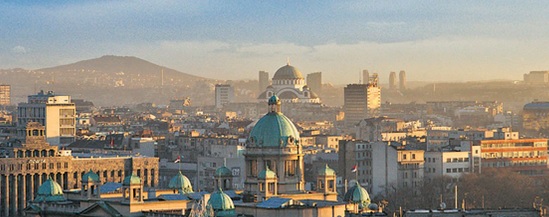We had to cross up and over the rolling hills of Fruska Gora in order to reach the motorway to Belgrade. The hillside road was abysmal, with deep ridges and chasms caused by weather damage and a random lumpy patchwork ‘repair’ of concrete.
Travelling before 9am meant we were in amongst local workers who flew along both sides of the narrow road at speed gambling on overtaking us at corners and into oncoming fast traffic. It was horrendous.


The motorway was an improvement, a toll road, and we navigated our way around Belgrade’s heavy traffic to find Camp Dunav alongside the Danube about 10kms north and west of the city. It was scruffy but clean and we had a warm welcome.
On a packed local bus before noon we hurtled alongside and then across the Danube to be dropped unceremoniously into the centre of a concrete jungle of noise, dust, heat, fast-moving traffic and pushing people.

Belgrade is not a pretty city. It has been both developed and destroyed over the last centuries and the overwhelming first impression now is of a ramshackle high rise centre in varying stages of dereliction and renewal. Looking up you can sometimes see remnants of grand baroque palaces from the time of the Habsburgs but in general the buildings are modern concrete and largely grimy, often covered with graffiti.
After a strong cup of coffee watching the comings and goings at the daily market, which is also the main bus station, we found our way along the pedestrian commercial shopping street to the citadel.
We wandered around the ancient Roman fortress that has been rebuilt 40 times as a result of different invasions, conquests and battles. Its situation on the confluence of the Danube and Sava rivers is spectacular and we enjoyed the view from the ‘Victor’ statue before the air was shattered by an impromptu fly past of military planes and helicopters.
Most people ignored the ear-crushing low-level display which we surmised was a regular occurrence. We endured four noisy fly pasts in the space of half an hour.


We found lunch on a terrace at a traditional Serbian restaurant in cobblestoned Skadorska. Tourists not locals were eating there, and not many of us. The food was good, a huge Caesar salad and a rolled and stuffed pork dish in mushroom gravy.
We meandered for the rest of the afternoon around the centre taking note of the relaxed attitudes despite the strain of heat, noise and dust. There seemed very little advertising of music, art or theatre events compared to say Budapest or Vienna, but there were plenty of flyposters promoting club nights out.
Expensive brand names mingled with cheap high street ones and the inevitable American chain food restaurants. The atmosphere was bustling but cheerful and people were settling down to eat in the many pavement cafes.
Belgrade is building its reputation as a party city and most of the clubs are along the sides of both rivers in converted houseboats. We walked past those on the Danube to see Zemun, a cosmopolitan suburb with an old cobblestone centre and bewildering bus stops.
It was time for a glass of beer and a moment’s peace as dusk fell on the Danube and families and friends enjoyed the last of the day’s heat.

Back at Bertha we reflected on a busy and interesting day in what would be our most Easterly destination on this trip.
We had discovered that key to a prime riverside development is private investment by Greek bankers. It seemed to underline Belgrade’s history of being continually built up and fought over by outside interests, whether by invading forces or foreign-seated dynasties in power.
It is a city with a fascinating history and an energetic drive for a better future. The name of the development is Hotel Yugoslavia. We wish it well.








